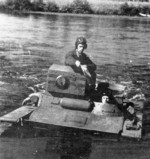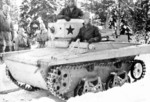T-37A
| Country | Russia |
| Manufacturer | No. 37 Plant, Moscow, Russia |
| Primary Role | Tankette |
Contributor: C. Peter Chen
ww2dbaseIn Feb 1932, the Soviet Union purchased British Vickers-Carden-Loyd Light Amphibious Tanks. After investigation, the British design inspired the T-37A design, which entered production in 1933, becoming the first mass-produced fully amphibious tanks in the world. Even though T-37A amphibious tanks were supposed to replace the older T-27 tankettes, the Soviet decision to keep both models in production at the No. 37 Plant named after N. Kozyrev in Moscow, Russia created problems, which were not equipped to maintain two distinct product lines. In the first half of 1933, only 30 examples were built (compared to the planned 255); in the second half of the year, 96 examples were built, which was still far below expectations. A change of management at No. 37 Plant in mid-1934, coupled with the start of T-37A production at the Izhorsky Plant in Leningrad, Russia and at subcontractor plants, finally increased production numbers, albeit at the cost of introducing wide variations between the vehicles produced at different locations. Production ceased in 1936 when the T-37A design was superseded by the T-38 design; between 1933 and 1936, about 1,200 examples were built. At the opening chapter of the European War, a large number of in-service T-37A amphibious tanks participated in the invasion of Poland, generally serving as reconnaissance vehicles and communications vehicles, and at times seeing combat as mobile machine gun platforms providing cover fire for advancing infantry. Many of them also served in Finland during the Winter War. They declined in numbers rapidly during the German invasion of 1941 as they were overrun by rapidly advancing German spearheads. As they had become obsolete by then, those surviving T-37A tanks were relegated to training and auxiliary defense roles in various parts of the Soviet Union.
ww2dbaseSource: Wikipedia
Last Major Revision: Jul 2015
T-37A Timeline
| 5 Feb 1932 | British firm Vickers and Soviet organization All-Russian Co-operative Society (ARCOS) entered into an agreement for the Soviet military's purchase of eight British Vickers-Carden-Loyd Light Amphibious Tanks. |
SPECIFICATIONS
T-37A
| Machinery | GAZ-AA 3.3L 4cyl inline engine rated at 40hp |
| Suspension | Coil sprung bogie |
| Armament | 1x7.62mm DT machine gun (585 rounds) |
| Armor | 3-9mm |
| Crew | 2 |
| Length | 3.75 m |
| Width | 2.10 m |
| Height | 1.82 m |
| Weight | 3.2 t |
| Speed | 35 km/h |
| Range | 185 km |
Photographs
 |  |  |  |
Did you enjoy this article or find this article helpful? If so, please consider supporting us on Patreon. Even $1 per month will go a long way! Thank you. Share this article with your friends: Stay updated with WW2DB: |
- » Wreck of USS Edsall Found (14 Nov 2024)
- » Autumn 2024 Fundraiser (7 Nov 2024)
- » Nobel Peace Prize for the Atomic Bomb Survivors Organization (11 Oct 2024)
- » Wreck of USS Stewart/DD-224 Found (2 Oct 2024)
- » See all news
- » 1,150 biographies
- » 337 events
- » 43,917 timeline entries
- » 1,241 ships
- » 350 aircraft models
- » 207 vehicle models
- » 375 weapon models
- » 123 historical documents
- » 260 facilities
- » 470 book reviews
- » 28,548 photos
- » 432 maps
Winston Churchill
Please consider supporting us on Patreon. Even $1 a month will go a long way. Thank you!
Or, please support us by purchasing some WW2DB merchandise at TeeSpring, Thank you!